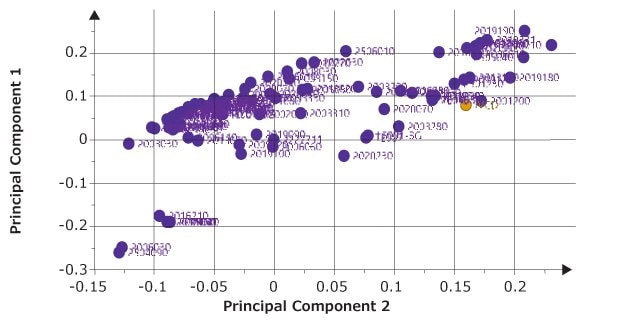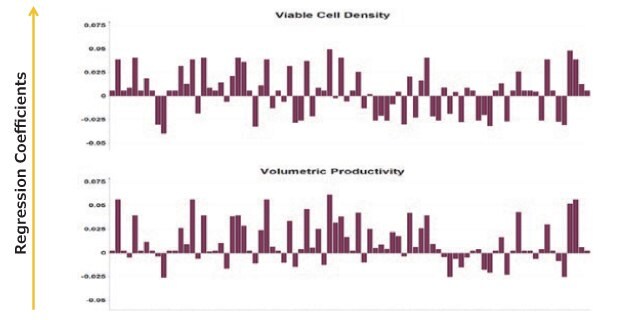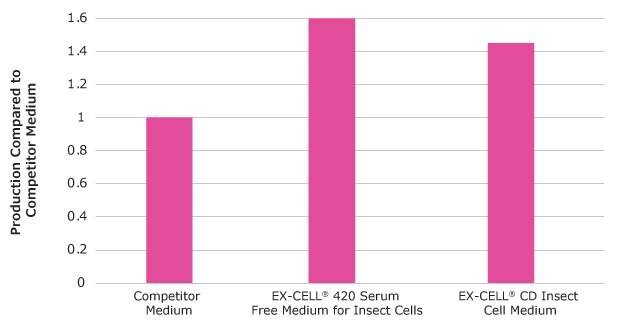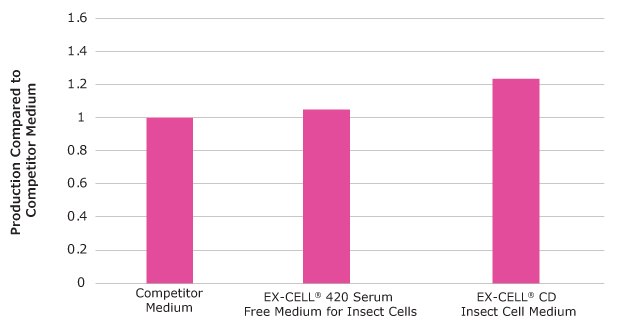Development of a Novel Sf9 Rhabdovirus-Negative Cell Line (Sf-RVN®) and Companion Chemically Defined Medium
The baculovirus-insect cell system (BICS) is widely used for production of recombinant proteins biologics for human and veterinary applications due to its flexibility, speed, simplicity and eukaryotic protein processing capacity. The BICS is also used for production of virus-like particles (VLP) used in vaccines and adeno-associated viruses (AAV) used in gene therapies.
Baculovirus is a rod-shaped virus that exclusively infects insects and therefore has relatively low safety concerns. It has a genome of 134 kilobase pairs with 154 open reading frames, which allows enough space for the gene insertions necessary to produce recombinant proteins, adeno-associated viruses (AAV) and virus-like particles (VLP).
The Sf9 Cell Line
Cell lines derived from ovarian tissue of the fall armyworm, Spodoptera frugiperda (Sf), are widely used as hosts in BICSs to produce recombinant proteins, virus-like particles (VLP) and viral vectors such as AAV. The original Sf cell line, designated IPLB-SF-21 (Sf21), was derived from pupal ovaries in 19771. Other commonly used Sf cell lines include Sf9, a subclone of Sf21.
Sf-rhabdovirus is a Common Contaminant of Sf9 Cell Lines
A novel rhabdovirus, known as Sf-rhabdovirus, was discovered to be a common and persistent contaminant of Sf9 cell lines. Sf-rhabdovirus is rod-shaped and contains single-stranded RNA. While its exact host range is not fully defined, it is believed that Sf-rhabdovirus is unlikely to be harmful for humans as it cannot replicate in mammalian cells2. Despite this finding, the presence of this adventitious agent in a process used to manufacture biologics for human use must be addressed. Removal of the virus can be achieved through use of appropriate downstream applications and its clearance must be confirmed by validated assays.
This article describes the development of a novel Sf9 Rhabdovirus-negative cell line, named Sf-RVN® Insect Cell Line, with companion chemically defined medium, the EXCELL® CD Insect Cell Medium. Combined, these two products form the Sf-RVN® Platform and offer a Sf-Rhabdovirus free alternative for the BICS production of biologics.
Characteristics of the Sf9 Rhabdovirus-Negative (Sf-RVN®) Insect Cell Line
An Sf9 cell line that is free from rhabdovirus was initially described in 2016 by Dr. Jarvis and the GlycoBac lab3. They demonstrated that the Sf-RVN® Insect Cell Line shows similar density, size, doubling time and morphology when compared to Sf9 cell lines infected with rhabdovirus (Figure 1). The absence of any viral sequences, including rhabdovirus, in the Sf-RVN® Insect Cell Line has been confirmed using the TBLASTN program to search massively parallel sequencing assemblies4. The nearly identical growth and morphology characteristics, along with this sequencing study, confirms that the Sf-RVN® Insect Cell Line is one of the best-characterized cell lines in the field of Sf9. It also proves that the Sf-RVN® insect cells are negative for rhabdovirus while maintaining other characteristics of the standard Sf9 cell line.

Figure 1.Comparison of Sf-RVN® insect cells and Sf9 cells infected with rhabdovirus revealed similarity in (A) density, (B) diameter), (C) doubling time, and (D) morphology. (Adapted from Maghodia et al., 2016)
Development of Optimized EX-CELL® CD Insect Cell Medium
Grace’s medium, supplemented with serum, is the earliest formulation developed for insect cell culture. The desire to move to a serum-free medium led to the addition of peptones, hydrolysates such as yeast extract, lipids and Poloxamer 188. These media are not chemically defined and variation in the hydrolysates results in lot-to-lot inconsistencies in the media and cell culture.
We developed a chemically defined medium optimized for insect cell culture (EX-CELL® CD Insect Cell Medium). Cell culture optimization technology was used to determine the best balance of components to deliver the desired cell growth and productivity. A key consideration during development of the specialty medium was the cell density effect. While Sf9 cells can reach peak densities of up to 107 cells/mL, if the density exceeds 4x106 cells/mL, there is a severe loss in protein yield. Ideally, infection should take place when the cells are at 2-3x106 cells/mL to achieve the highest protein yield.
Several media formulations were used as a starting point to allow for the evaluation of a diverse range of components and concentrations. Unique components of insect cell media were then added to these formulations. One of these starting formulations was our EX-CELL® 420 Serum-Free Medium for insect cells with the yeast extract removed. A design of experiments (DOE) approach was used to identify those biochemical components that supported growth and productivity of the Sf-RVN® Insect Cell Line.

Figure 2.Identification of critical biochemical components by two-dimensional mapping of cell culture performance.
Figure 2 is an example of a multivariate analysis of components. The yellow dot in the upper right quadrant represents cell growth while the purple dots are individual components of the medium. Components which are near the yellow dot have a positive effect on the response. For example, component 2001200 is adjacent to the yellow dot and therefore necessary for growth. Components in the lower left quadrant had a negative effect on growth. While it may seem obvious to remove those components in the lower left quadrant, these components may still be important for productivity. This statistical mapping can be expected to provide a good indication of the significance of a component, but it’s necessary to confirm that the component have sufficient statistical variance for the software to detect it as a critical component.
From the same experiment, it is possible to determine the effect each component has on Sf-RVN® insect cell growth. The variable importance on projection (VIP) response ranks components based on how much of an effect a component has. Any component with a ranking greater than one is critical (Figure 3). However, the graph does not indicate if those critical components are positive or negative effectors for growth. Any component at the far right-hand side has a low ranking and would once again be considered for removal from the medium as they have little to no effect on growth. As noted above, these components must then be evaluated for their effect on productivity.

Figure 3.Identification of critical biochemical components ranked by variable importance.
A graph of regression components indicated if the components had a positive or negative correlation to individual responses compared to all other components (Figure 4). Bars that are above zero have a positive effect while those below zero have a negative effect. The top graph represents components critical for cell growth while the bottom graph shows critical components for productivity. It is obvious there are components that are important for growth and not for productivity and vice versa.
These three sets of data indicated which components should be included in the medium and which can be eliminated from consideration. The data also provided concentration ranges to test for both growth and productivity to create EX-CELL® CD Insect Cell Medium. While EX-CELL® CD Insect Cell Medium is optimized for the Sf-RVN® Insect Cell Line, this medium is compatible with other insect cell lines such as Sf9, Sf21, Tni, S2 and C636.

Figure 4.Regression coefficients reflect positive and negative correlations of biochemical components to individual responses.
Sf-RVN® Platform Performance
Performance of the Sf-RVN® Platform, composed of the Sf-RVN® Insect Cell Line with the specifically formulated EX-CELL® CD Insect Cell Medium, was evaluated using several assays:
- Cell growth assay: Measures Sf-RVN® Insect Cell Line growth in EX-CELL® CD Insect Cell Medium vs. other media
- Protein production: Measures production of various proteins including hEPO (human erythropoietin) and SEAP (secreted embryonic alkaline phosphatase)in Sf-RVN® Insect Cell line using EX-CELL® CD Insect Cell Medium vs. other media
- AAV production: Measures production of AAV2 in both Sf-RVN® and Sf9 cells in EX-CELL® CD Insect Cell Medium vs. other media
EX-CELL® CD Insect Cell Medium Supports Stable Growth Over Multiple Passages
Figure 5 shows a comparison of cultivation stability of the Sf-RVN® Insect Cell Line when grown in the EX-CELL® CD Insect Cell Medium, competitor medium and EX-CELL® 420 Serum-Free Medium containing yeast extract. The chemically defined medium consistently reached 6-8x106 cells/mL by day 4 when seeded at 0.7-1x106 cells/mL and reached more than 10x106 cells/mL by day 7 when seeded at 0.5x106 cells/mL. Viability remained consistently high throughout the culture period. Competitor medium varied from 3-5x106 cells/mL during passing with a maximum viable cell density of 5x106 cells/mL on day 7 of the growth curve.

Figure 5.Stable growth of the Sf-RVN® Insect Cell Line over multiple passages.
The EX-CELL® 420 Serum-Free Medium showed slightly better growth as compared to the competitor medium but not as good as the chemically defined medium. EX-CELL® 420 Serum-Free Medium, which contains hydrolysates, showed some passage-to-passage variability. This variability emphasizes the advantage of culturing with a chemically defined medium as it provides improved consistency during the cell culture process.
EX-CELL® CD Insect Cell Medium Supports High Protein Production Levels
Figure 6 shows the production of secreted alkaline phosphatase (SEAP) by the Sf-RVN® Insect Cell Line in the same three media. The baculovirus producing SEAP is an occlusion-negative virus, which means it is secreted directly into the supernatant. Cells were plated at 1x106 cells/mL (day zero) and infected on day 1 when the cultures were at approximately 2x106 cells/mL. The Sf-RVN® insect cells were infected at a multiplicity of infection (MOI) of 5 and harvested on day 3 post-infection. All the baculovirus used for these experiments had been passaged twice in the EX-CELL® CD Insect Cell Medium prior to the final infection.

Figure 6.Comparison of SEAP production by Sf-RVN® insect cells in three different media formulations.
As shown in Figure 6, production of SEAP was 36% higher with the EX-CELL® CD Insect Cell Medium than with the competitor medium. Production in EX-CELL® 420 Serum-Free Medium was slightly higher (48%). While the EX-CELL® 420 Serum-Free Media produces higher levels of protein, this media is not chemically defined and is challenged by lot-to-lot consistency.
EX-CELL® CD Insect Cell Medium Supports High Rudolph Red and Human EPO Production
In this study, the baculovirus was co-infected with Rudolph Red and human Erythropoietin (hEPO). Human EPO is secreted into the supernatant and can be directly measured while the Rudolph Red remains intracellular and once released from the cells, is quantified with a fluorescent plate reader. The infection was done at an MOI of 5 and harvested on day 3 post-infection.
As shown in Figure 7, production of Rudolph Red was 45% higher with the EX-CELL® CD Insect Cell Medium than with the competitor medium.

Figure 7.Comparison of Rudolph Red production in Sf-RVN® cells in three different media formulations.
EX-CELL® CD Insect Cell Medium Supports High Levels of Porcine Parvovirus Production
Similar to AAV, PPV is a capsid virus in which the polyhedral nuclear capsid will remain within the cell. Both AAV and PPV are small, non-enveloped single-stranded DNA viruses that are assembled from three viral proteins: VP1, VP2, and VP3.
As with the previous studies, infection was at an MOI of 5 with approximately 2x106 cells/mL on day 1 of the culture and harvest was on day 3 post-infection. The EX-CELL® CD Insect Cell Medium outperformed both the competitor medium and EX-CELL® 420 Serum-Free Medium by 22% (Figure 8).

Figure 8.Comparison of PPV production in Sf-RVN® cells in three different media formulations.
Conclusion
Despite the discovery that Sf9 cells are contaminated with Sf-rhabdovirus, these cell lines are widely used as hosts to produce recombinant proteins, virus-like particles (VLP) and adeno-associated viruses (AAV) used for gene therapy applications. While it is believed that this virus is unlikely to be harmful to humans, removal of rhabdovirus, as with any adventitious agent, is advised to ensure patient safety.
Data confirms that the EX-CELL® CD Insect Cell Medium not only supports robust growth of the Sf-RVN® Insect Cell Line, but also supports the production of proteins using baculovirus.
The Sf-RVN® Insect Cell Line is demonstrated to be free of the contaminating virus and improves the safety profile of bioprocesses. The combination of this cell line with the EX-CELL® CD Insect Cell Medium forms the Sf-RVN® Platform and provides robust growth and productivity.
Products
References
如要继续阅读,请登录或创建帐户。
暂无帐户?